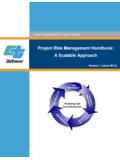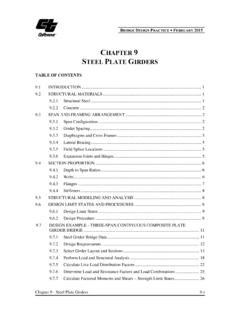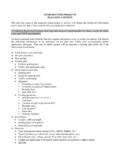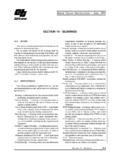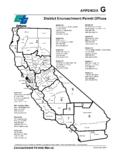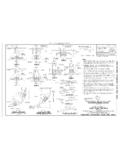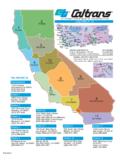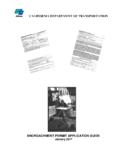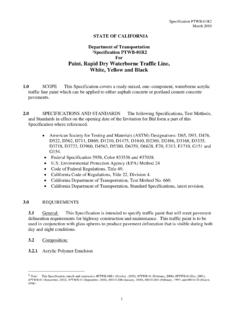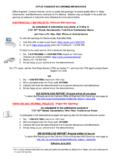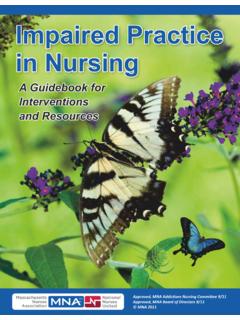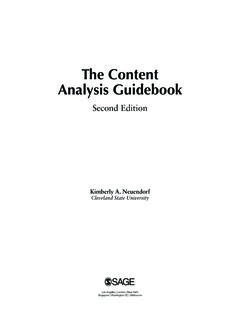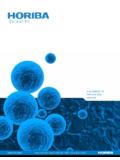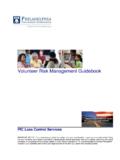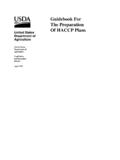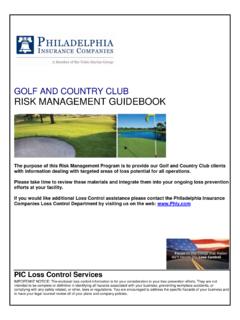Transcription of KNOWLEDGE TRANSFER - California Department …
1 KNOWLEDGE TRANSFER . GUIDEBOOK. Inform &. Engage 1. K nowledge TRANSFER . What is KNOWLEDGE TRANSFER , and how can it help you? We must begin by first describing workforce planning, and the pivotal role KNOWLEDGE TRANSFER plays in ensuring the success of our workforce. Workforce planning strives to have the right people in the right jobs at the right time. Succession planning focuses on having the right leadership in place, and is an important component of the overall workforce planning process. Caltrans has a Workforce Planning unit in the Division of Human Resources, (DHR) and has established strategic goals related to workforce and succession planning and KNOWLEDGE TRANSFER . This guidebook was developed by a Caltrans team as part of our strategic goal delivery. The techniques and tools described later are gleaned from industry best practices, and present several options for a supervisor to choose from, based on the needs of their work unit.
2 Currently, Caltrans has developed workforce plans for twelve occupational areas. Caltrans's workforce planning efforts focused first on Maintenance classes, and then on those classifications which feed into our CEA classification. The California Department of Human Resources' (CalHR) Seven-Step Workforce Planning Model describes a cyclical process, which includes steps for assessing and analyzing workforce gaps, developing priorities and implementing solutions. 2. As of March 2014, approximately 54% of the Department 's workforce and 66% of the Department 's Managers and Supervisors were at, or were within three years of, retirement age. As mid-level managers promote to CEAs, a ripple effect will be created at all levels of management and supervision. 5,000 Employee Count = 19,047. 4,500 4,082. CALTRANS. ALL CLASSIFICATIONS. 3,668. 4,000 TOTAL. # of EMPLOYEES. 3,239. 3,500. 3,000 2,369. 2,500. 1,797. 2,000 1,576.
3 1,500 1,025. 1,000 502 486. 218. 500 85. 0. 24 or 25-29 30-34 35-39 40-44 45-49 50-54 55-59 60-64 65-69 70+. Less AGE RANGE. Moving forward, Caltrans must make a concerted effort to capture and impart the institutional KNOWLEDGE within its ranks before staff leave via retirement. To address the looming gaps in workforce KNOWLEDGE , common practices and techniques of KNOWLEDGE TRANSFER utilized by many public and private entities are summarized in this guidebook. First, it is important to note the differences between the two types of KNOWLEDGE . KNOWLEDGE can be explicit, which lends itself to TRANSFER strategies such as formal desk manuals, procedures, and other codified processes. KNOWLEDGE can also be tacit, which lends itself to TRANSFER strategies such as mentoring, coaching, communities of practice and the like. Explicit KNOWLEDGE is more easily quantified and qualified, and can thus be more readily captured.
4 Tacit KNOWLEDGE , however, involves soft skills, personal characteristics, development of cooperative partnerships, and subjective situational judgments. As this type of KNOWLEDGE is more intuitive in nature and derived from experience, it is less readily distilled and captured into orderly process structures. Since these characteristics are essential for leaders, we strongly suggest devoting more attention to the transferring of tacit KNOWLEDGE . 3. 4. In order to determine what succession planning techniques our Department should focus on, we performed a needs assessment on what individual managers and supervisors are doing currently. In January 2012, a survey was circulated to Departmental managers and supervisors to determine what succession planning strategies are currently in use, what needs exist, and what KNOWLEDGE they find to be the most critical to capture (explicit vs. tacit). Survey results indicated that managers/supervisors currently rely heavily on the use of formal training and desk manuals for KNOWLEDGE TRANSFER .
5 These methods are best used for transferring explicit information, and while they clearly provide a strong foundation for KNOWLEDGE TRANSFER , it only addresses a portion of the KNOWLEDGE equation. It was our aim to identify various techniques and strategies that could better bring about the TRANSFER of tacit KNOWLEDGE . FOUR BUILDING BLOCKS. Caltrans developed a model for KNOWLEDGE TRANSFER that relies on a foundation of excellent leadership (predicated on the Department 's mission, vision, and several goals) sound hiring practices, established techniques of manuals and formal training, while providing four dynamic strategies for specific tacit KNOWLEDGE TRANSFER . Face-to-Face: Group This type of KNOWLEDGE TRANSFER focuses on one person transferring KNOWLEDGE to a group of other people. This is a good technique to use when the KNOWLEDGE is something that many people can benefit from, and it can be conveyed in sufficiently broad terms to be suitable for a lecture format.
6 Examples include Expert Storytelling; Tailgate Meetings; In-House Workshops; Education Committees; Lessons Learned. Face-to-Face: Individual This technique relies on a personal interaction between two people, with one person transferring the KNOWLEDGE to the other. This technique is great if you have a multiple KNOWLEDGE bases or techniques to TRANSFER , or a great deal of specific technical detail. Examples include Cross Training; Peer Mentoring /. Apprenticeship; Job Shadowing; Formal Mentoring Multimedia The world is full of useful technology, and this technique leverages it to store specific KNOWLEDGE . If there is information that many people may want to readily access, this is a good strategy to store various types of KNOWLEDGE , such as Wiki Page;. Digital Content Management; Library Resources; Exit Interviews. Rotational Programs Establishing rotation programs to allow employees to learn various functional areas in a discipline is a great tool to build KNOWLEDGE .
7 If there are multiple areas of specialized skill in a work unit, the use of formal or informal rotation programs can build skills. Be sure to check with Human Resources, Labor Relations and Budget Resources before starting a rotational assignment. In the remainder of this guidebook, specific examples are provided for each technique, and how they could be introduced into your particular District/Division/Unit. Happy KNOWLEDGE TRANSFER ! 5. 6. KNOWLEDGE TRANSFER . TECHNIQUES & TOOLS. TACIT KNOWLEDGE FOCUS. CATEGORY FACE-to-FACE: GROUP. Boot Camp Best Practices Meetings / Studies (In-House Workshops; Education Committees; @ Tailgate Meetings). Communities of Practice Critical Incident Reviews / Lessons Learned Expert Storytelling KNOWLEDGE Fairs BOOT CAMP. Specific Topic: A subject matter expert (SME) conducts a training session or sessions on a specific topic. Only one topic is covered and in a relatively short session (no longer than 4 hours).
8 The topic may be an application or a unique aspect of it ( , a new approach to records management, a review or reconsideration of constructive intervention, a hands-on training to use or maintain a specific piece of equipment, etc.). The focus is on one topic only; and if something else arises during the session, it will be set aside for the SME to conduct future training sessions. What Multiple Topics: For offices with multiple areas of operations, the Boot Camp can consist of training modules designed for KNOWLEDGE that is applicable to: (1) all operational areas; and/or (2). specific or limited operational areas. User guides and mentor programs may be incorporated into these modules. New and existing staff shall go through sequences of training sessions depending on their assignments. Allows questions to be addressed for the benefit of all instead of the SME receiving similar Why individual questions over a period of time.
9 When Refresher training is needed in a complex or evolving subject area Determine what topic or topics need to be addressed. Identify SME(s) and develop presentation How materials and/or modules for training session(s). Stay on point; guard against tangents Do's & Don'ts Session should not exceed a half day (4 hours). Blend of singular/multiple topics: The Department of General Services (DGS) Building and Generic Example Property Management Branch uses this strategy to combine KNOWLEDGE TRANSFER and staff development efforts for a number of classifications and functions. The Office of Discipline Services offers a supervisor refresher course on progressive discipline. The 4-hour class is well-paced and hits key refresher points, while providing helpful reference Caltrans documents and contact listings. Various divisions and districts have used this course in a boot Examples camp setting. Attendee reviews have said it was insightful, concise, and a very good use of their time.
10 7. BEST PRACTICES MEETINGS / STUDIES. (In-House Workshops; Education Committees; @ Tailgate Meetings). Best practices meetings/studies look for different processes or systems to perform work that have had measurable success and effectiveness and are likely transferable. Best practices are What found in a variety of ways; through meetings of similar functional groups, polling employees, or surveying for best practices. Identifies practices that have worked in other organizations and may be transferable Shares current practices and processes Why Can spark innovation To streamline a process or identify efficiencies Can broaden networks and increase performer expertise New process, task, or competency needs to be developed An existing process, task or competency needs modification When New process or success needs to be marketed internally or to other areas Success depends on staying up-to-date; focus is on gathering info Determine what KNOWLEDGE needs to be shared.
